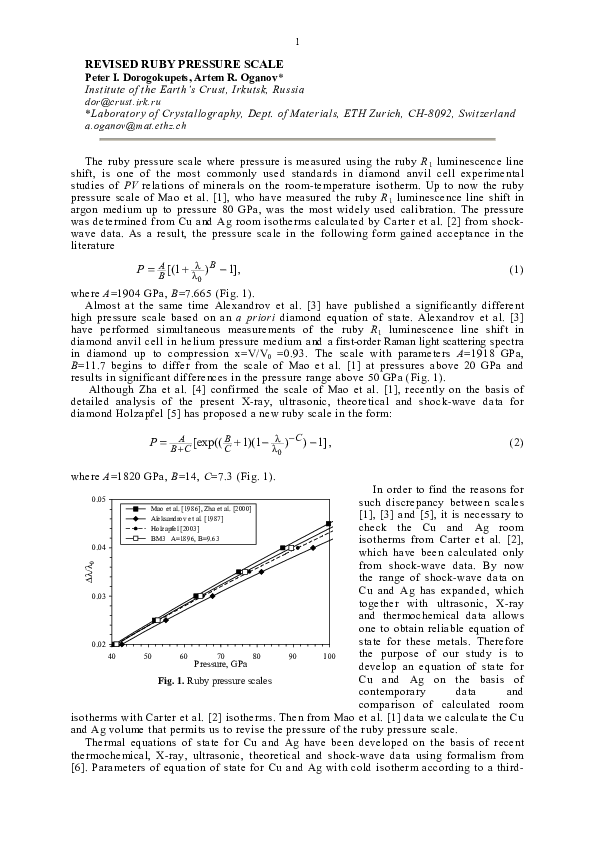Academia.edu no longer supports Internet Explorer.
To browse Academia.edu and the wider internet faster and more securely, please take a few seconds to upgrade your browser.
Revised Ruby Pressure Scale
Related Papers
Doklady Earth Sciences
Equations of state of Al, Au, Cu, Pt, Ta, and W and revised ruby pressure scale2006 •
2007 •
2007 •
MRS Proceedings
The Ruby Scale at Megabar Pressures1997 •
ABSTRACTDiamond anvil cells revolutionized high pressure research because they provided easy to generate extremely high pressures with an optical window on the sample and an easy-to-use pressure gauge based on the shift with pressure of the ruby fluorescence spectrum. The ruby scale provides an accurate method of determining pressure distributions within samples. However, at pressures above 100 GPa measurement of the ruby fluorescence begins to become difficult due to weakening signals, interference from intense diamond fluorescence, and ultimately, strong absorption of the exciting laser by diamond itself. We shall discuss a number of methods which have been devised to extend the ruby pressure optical gauge to 500 GPa, including quasi-direct pumping of the ruby R-lines.
arXiv (Cornell University)
Correction of the pressure scales reliant to the thermal pressures shifts in iron (3d) vanadium (4d), iridium and platinum (5d) transition metals2022 •
We present our recent new calibration of the ruby pressure scale based on experimentally obtained reference curves. We discuss important points for accurate calibration of the ruby gauge: use of an appropriate experimentally-based calibration method, use of quasi-hydrostatic data, and the question of the fitting form used for extrapolation.
High Pressure Research
Equations of state of MgO, Au, Pt, NaCl-B1, and NaCl-B2: Internally consistent high-temperature pressure scales2007 •
An Equation of State for Metals at High Temperature and Pressure in Compressed and Expanded Volume Regions
An Equation of State for Metals at High Temperature and Pressure in Compressed and Expanded Volume Regions2019 •
A simple equation of state model for metals at high temperature and pressure is described. The model consists of zero-temperature isotherm, thermal ionic components, and thermal electronic components, and is applicable in compressed as well as expanded volume regions. The three components of the model, together with appropriate correction terms, are described in detail using Cu as a prototype example. Shock wave Hugoniot, critical point parameters, liquid-vapor phase diagram, isobaric expansion, etc., are evaluated and compared with experimental data for Cu. The semianalytical model is expected to be useful to prepare extended tables for use in hydrodynamics calculations in high-energy-density physics.
RELATED PAPERS
2016. In Rethinking Race in Modern Argentina, edited by Paulina Alberto and Eduardo Elena. Cambridge: Cambridge University Press.
The Savage Outside of White ArgentinaDiálogos con la jurisprudencia (256)
Desafíos en el análisis de la medida de prisión preventiva en sede constitucional. Una mirada crítica del hábeas corpus a favor de Keiko Fujimori Higuchi2020 •
Revista CIDOB d'Afers Internacionals, nº. 136
América Latina en el nuevo escenario internacional: ¿qué espacio hay para el regionalismo y la cooperación regional?A Companion to Indian Cinema, Wiley Blackwell
Technological Obsolescence and Space in Bombay Cinema2022 •
Diabetes, Obesity and Metabolism
Nonalcoholic fatty liver disease and osteoporosis: A potential association with therapeutic implications2022 •
2024 •
Scripta Metallurgica
Energie de liaison lacune-atome de zinc dans des alliages AlZn dilues1972 •
2016 •
Journal of Innovative Science Education
Development e-TBL to Analyze Critical Thinking Skills and Problem Solving in Learning of Substance and Characteristics2020 •
Acta Crystallographica Section E Structure Reports Online
2,3-Dibromo-1-(4-methylphenyl)-3-(5-nitrofuran-2-yl)propan-1-one2010 •
Pertanika journal of social science and humanities
Challenges in Academic Speaking for Non-Native Speakers: The Case of Libyan Students Studying in Malaysia2022 •
2016 •
International Journal Of Community Medicine And Public Health
Applications for data collection: AppDatCol2021 •
Kirkuk University Journal-Scientific Studies
Some neotectonic notes on the selected topographic expressions between shari and tharthar lakes2010 •
- Find new research papers in:
- Physics
- Chemistry
- Biology
- Health Sciences
- Ecology
- Earth Sciences
- Cognitive Science
- Mathematics
- Computer Science

 Artem Oganov
Artem Oganov